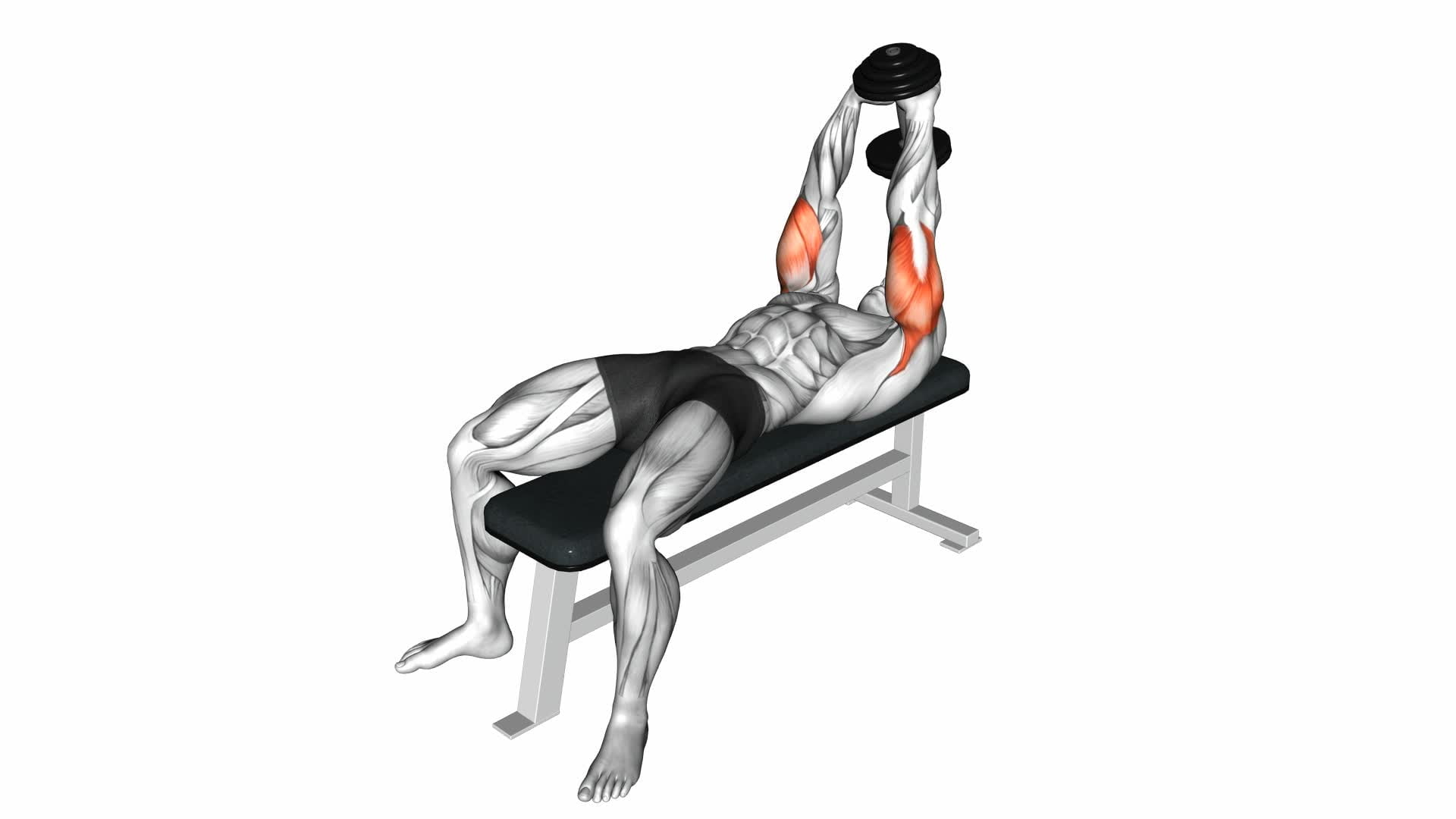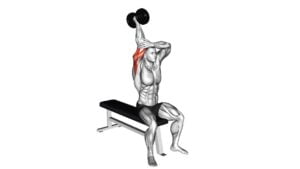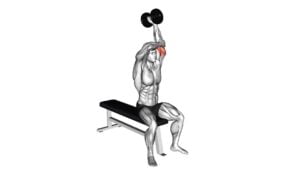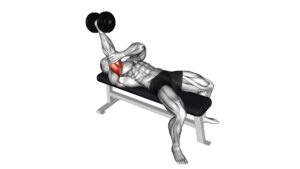Dumbbell Lying Single Extension – Video Exercise Guide & Tips

Looking to strengthen your triceps? The dumbbell lying single extension is a great exercise to add to your routine. By following proper form and technique, you can effectively target and tone your triceps muscles.
Watch This Exercise Video
In this video exercise guide, you'll find step-by-step instructions and helpful tips to maximize your results. So grab a pair of dumbbells and get ready to feel the burn in your arms.
Let's dive into the dumbbell lying single extension!
Key Takeaways
- Dumbbell Lying Single Extension targets and tones triceps muscles.
- Proper form and technique are crucial for maximizing effectiveness and preventing injuries.
- Gradually increasing the weight challenges and develops the triceps muscles.
- Incorporating variations and progressions keeps the exercise challenging and prevents plateaus.
Benefits of Dumbbell Lying Single Extension
You should regularly incorporate the dumbbell lying single extension into your workout routine because it provides numerous benefits for your triceps. This exercise specifically targets the triceps muscles, which are located on the backside of your upper arm. By performing the dumbbell lying single extension, you can effectively strengthen and tone your triceps, leading to improved arm strength and definition.
One of the main benefits of this exercise is that it allows you to isolate the triceps muscles, meaning you can target them directly without involving other muscle groups. This is important for individuals who want to specifically focus on their triceps or who may have imbalances in their arm strength.
Additionally, the dumbbell lying single extension can easily be modified to suit different fitness levels and goals. For beginners, using lighter weights or starting with bodyweight-only can be a great way to build strength and confidence. As you progress, you can gradually increase the weight or try more challenging variations, such as performing the exercise on an incline bench.
In conclusion, incorporating the dumbbell lying single extension into your workout routine can provide numerous benefits for your triceps. Not only does it target and strengthen the triceps muscles, but it can also be modified to suit different fitness levels and goals.
Now, let's move on to the equipment needed for this exercise.
Equipment Needed for the Exercise
To successfully perform the Dumbbell Lying Single Extension exercise, you'll need a few key pieces of equipment.
First and foremost, you'll need a dumbbell, preferably one that's comfortable for you to grip.
Additionally, it's important to have a workout bench or a stable surface to lie on.
Finally, having a mat or towel to provide cushioning for your head and back can enhance your comfort during the exercise.
With these essential pieces of exercise equipment, you'll be ready to engage in the Dumbbell Lying Single Extension exercise and reap its benefits.
Required Equipment for Exercise
To perform the Dumbbell Lying Single Extension exercise, you'll need a dumbbell. Here are the four essential items needed for this exercise:
- Dumbbell: Choose a weight that challenges you without compromising proper form. Start with a weight that allows you to complete 8-12 reps with proper technique.
- Exercise Mat: Lay an exercise mat on the floor to provide cushioning and support for your back and shoulders during the exercise.
- Bench: Use a flat or incline bench to lie down and support your upper body. Ensure that the bench is stable and secure before starting the exercise.
- Stopwatch or Timer: Use a stopwatch or timer to track your rest periods between sets. This will help you maintain an efficient workout and optimize your results.
By having these items ready, you can perform the Dumbbell Lying Single Extension exercise properly and experience the benefits it offers, such as strengthening your triceps and improving overall upper body strength.
Remember to always prioritize proper exercise form to avoid injuries and maximize the effectiveness of your workout.
Key Exercise Equipment
When performing the Dumbbell Lying Single Extension exercise, it's important to have the necessary equipment. To properly execute this exercise, you'll need a dumbbell. The weight of the dumbbell will depend on your fitness level and goals. Start with a weight that challenges you, but still allows you to maintain proper form.
If you don't have access to dumbbells, you can use household items such as water bottles or canned goods as makeshift weights. Additionally, exercise modifications can be made if you don't have a bench or mat. You can perform this exercise on the floor or use a stable surface like a step or sturdy chair.
These modifications allow for home workout options, making it accessible for those who don't have access to a gym. Remember to always prioritize safety and proper form when performing any exercise.
Essential Exercise Equipment
You will need a dumbbell for the Dumbbell Lying Single Extension exercise in order to effectively perform the exercise.
When it comes to strength training, there are different types of exercise equipment that can be used to target specific muscle groups and achieve your fitness goals.
Here are four factors to consider when choosing the right exercise equipment for your fitness goals:
- Targeted muscle group: Determine which muscle group you want to work on and choose equipment that specifically targets that area. For the Dumbbell Lying Single Extension, the dumbbell helps to isolate and strengthen the triceps.
- Weight range: Select equipment that allows you to adjust the weight according to your current strength level. This ensures that you can gradually increase the resistance as you progress.
- Comfort and safety: Ensure that the equipment is comfortable to use and provides proper support to avoid any risk of injury. It should feel stable and fit your body type.
- Space and budget: Consider the available space in your workout area and your budget constraints. Choose equipment that fits within your space and financial limitations.
Proper Form and Technique Tips
To perform the dumbbell lying single extension with proper form and technique, there are a few key points to keep in mind.
First, ensure that you maintain a stable position by lying flat on a bench and keeping your core engaged throughout the exercise.
Secondly, focus on extending your arm fully and squeezing your triceps at the top of the movement to maximize results.
Form Essentials for Extension
Mastering proper form and technique is essential for executing the Dumbbell Lying Single Extension effectively. Here are four form essentials to keep in mind for this exercise:
- Proper Technique:
Lie on a flat bench with a dumbbell in one hand, extended above your chest. Slowly lower the dumbbell towards your head while keeping your upper arm stationary. Pause briefly, then extend your arm back to the starting position. Ensure controlled movements throughout the exercise.
- Muscle Activation:
Focus on engaging your triceps throughout the movement. Keep your core engaged and maintain a stable position on the bench to maximize muscle activation in your triceps.
- Elbow Position:
Keep your elbow close to your head as you lower the dumbbell. This will help target the triceps more effectively.
- Breathing:
Inhale as you lower the dumbbell and exhale as you extend your arm back to the starting position. This breathing pattern helps maintain stability and control.
Technique for Maximum Results
To achieve maximum results with the Dumbbell Lying Single Extension, focus on maintaining proper form and technique throughout the exercise. Proper form ensures that you're effectively targeting the muscles and maximizing gains.
Start by lying flat on your back on a bench, holding a dumbbell in one hand with your arm fully extended. Slowly lower the dumbbell towards your head by bending your elbow, keeping your upper arm stationary. Pause for a moment at the bottom, then extend your arm back up to the starting position.
Throughout the movement, make sure to keep your core engaged and your back flat against the bench. Avoid using momentum or swinging the weight, as this can decrease the effectiveness of the exercise.
Variations and Progressions
Start by incorporating different weights and increasing the difficulty level of the exercise to challenge yourself and make progress with the Dumbbell Lying Single Extension.
Here are some variations and progressions you can try:
- Increase the weight: As you become comfortable with a certain weight, gradually increase the load to continue challenging your muscles and promoting strength gains. Start with a weight that allows you to perform the exercise with proper form and then increase it as you get stronger.
- Change the grip: Instead of using a neutral grip, you can try using a pronated or supinated grip. This variation targets different muscles and adds variety to your workout routine.
- Use resistance bands: Incorporating resistance bands can add an extra challenge to the exercise. Attach the bands to the dumbbells and perform the lying single extension while maintaining tension on the bands throughout the movement.
- Combine with other exercises: To further enhance the difficulty level, you can combine the dumbbell lying single extension with other exercises. For example, you can perform a dumbbell lying single extension followed by a dumbbell bench press to create a superset that targets both the triceps and chest muscles.
By incorporating these variations and progressions into your workout routine, you can continue to challenge your muscles and make progress with the dumbbell lying single extension exercise.
Remember to always use proper form and listen to your body to avoid injury.
Common Mistakes to Avoid
As you progress with the Dumbbell Lying Single Extension, it's important to be aware of common mistakes to avoid. Proper technique is crucial to ensure maximum effectiveness and prevent injuries.
One common mistake is using excessive weight. While it may be tempting to go heavy, using too much weight can compromise your form and increase the risk of strain or muscle imbalances. It's important to start with a weight that allows you to maintain proper form throughout the exercise.
Another mistake to avoid is using momentum to lift the dumbbells. This can occur when you swing your arms or use your body to generate momentum instead of relying on the targeted muscle group. To avoid this, focus on performing the exercise in a slow and controlled manner, emphasizing the contraction of the triceps.
Additionally, watch out for improper wrist positioning. Keep your wrists in a neutral position throughout the movement, avoiding excessive flexion or extension. This will help maintain stability and prevent strain on the wrists.
Lastly, ensure that your shoulders and elbows remain stable and stationary during the exercise. Avoid any unnecessary movement or rotation, as this can reduce the effectiveness of the exercise and put strain on other muscles.
Tips for Incorporating Dumbbell Lying Single Extension Into Your Workout Routine
Incorporate the Dumbbell Lying Single Extension into your workout routine by focusing on proper form and gradually increasing the weight for optimal triceps development. This exercise effectively targets the triceps, helping you build strength and definition in this muscle group.
Here are some tips to help you incorporate this exercise into your routine:
- Start with a lighter weight: When incorporating dumbbell exercises into your routine, it's important to start with a weight that allows you to maintain proper form throughout the movement. This will help prevent injury and ensure that you're effectively targeting the triceps.
- Engage your core: To maintain stability during the exercise, engage your core muscles by pulling your belly button towards your spine. This will help keep your body stable and prevent any unnecessary movements.
- Focus on proper technique for extensions: When performing the Dumbbell Lying Single Extension, keep your elbows close to your head and your upper arms stationary. Lower the dumbbell towards the floor, keeping your wrists straight and your elbows in line with your shoulders. Then, extend your arms back up, fully contracting your triceps at the top of the movement.
- Gradually increase the weight: As you become comfortable with the exercise and your form improves, gradually increase the weight to continue challenging your triceps. However, always prioritize proper form over the amount of weight you're lifting.
Frequently Asked Questions
How Many Sets and Reps Should I Do for the Dumbbell Lying Single Extension?
To determine the number of sets and reps for the dumbbell lying single extension, you should consider your fitness goals and current strength level. Generally, it's recommended to start with 2-3 sets of 8-12 reps. However, you can adjust these numbers based on your personal preferences and capabilities.
It's important to gradually increase the weight and intensity over time to challenge your muscles and promote growth. There are also variations of the dumbbell lying single extension that you can incorporate for added variety and muscle engagement.
Can I Perform the Dumbbell Lying Single Extension Exercise With a Resistance Band Instead of Dumbbells?
Yes, you can perform the dumbbell lying single extension exercise with a resistance band instead of dumbbells. Using a resistance band provides a great alternative and has its own benefits.
It helps to increase muscle strength and endurance, improves flexibility, and can be easily adjusted to different resistance levels. Resistance bands also target and engage stabilizer muscles, enhancing overall muscle activation.
Incorporating resistance bands into your workout routine can add variety and challenge to your exercises.
Is the Dumbbell Lying Single Extension Exercise Suitable for Beginners?
The dumbbell lying single extension exercise can be a challenging move for beginners. If you're just starting out, it's important to focus on proper form and technique to avoid injury.
There are modifications you can make to this exercise to make it more suitable for beginners, such as using lighter weights or starting with alternative exercises that target the same muscle groups.
It's always a good idea to consult with a fitness professional to ensure you're performing exercises correctly and safely.
How Often Should I Incorporate the Dumbbell Lying Single Extension Exercise Into My Workout Routine?
To determine the frequency of incorporating the dumbbell lying single extension exercise into your workout routine, consider your current fitness level and goals.
Start by doing this exercise once or twice a week. As you progress and become more comfortable, gradually increase the frequency to three or four times a week.
Remember to listen to your body and give yourself enough time to rest and recover between workouts.
Consistency and proper form are key to seeing results.
Can the Dumbbell Lying Single Extension Exercise Help With Improving Shoulder Stability?
The dumbbell lying single extension exercise can definitely help with improving shoulder stability. Shoulder stability is important for maintaining proper form and preventing injuries during various exercises.
By performing this exercise, you engage the muscles in your shoulders and upper back, which helps to strengthen and stabilize the shoulder joint. The benefits of shoulder stability training include enhanced posture, improved athletic performance, and reduced risk of shoulder injuries.
Incorporating this exercise into your routine regularly can greatly contribute to improving shoulder stability.
Conclusion
In conclusion, the dumbbell lying single extension is a beneficial exercise that targets and strengthens the triceps.
It can be performed with minimal equipment and is easy to incorporate into your workout routine.
By following proper form and technique, avoiding common mistakes, and gradually progressing the exercise, you can maximize its effectiveness.
Remember to consult a fitness professional if you have any concerns or questions about incorporating this exercise into your fitness regimen.

Author
Years ago, the spark of my life’s passion ignited in my mind the moment I stepped into the local gym for the first time. The inaugural bead of perspiration, the initial endeavor, the very first surge of endorphins, and a sense of pride that washed over me post-workout marked the beginning of my deep-seated interest in strength sports, fitness, and sports nutrition. This very curiosity blossomed rapidly into a profound fascination, propelling me to earn a Master’s degree in Physical Education from the Academy of Physical Education in Krakow, followed by a Sports Manager diploma from the Jagiellonian University. My journey of growth led me to gain more specialized qualifications, such as being a certified personal trainer with a focus on sports dietetics, a lifeguard, and an instructor for wellness and corrective gymnastics. Theoretical knowledge paired seamlessly with practical experience, reinforcing my belief that the transformation of individuals under my guidance was also a reflection of my personal growth. This belief holds true even today. Each day, I strive to push the boundaries and explore new realms. These realms gently elevate me to greater heights. The unique combination of passion for my field and the continuous quest for growth fuels my drive to break new ground.







